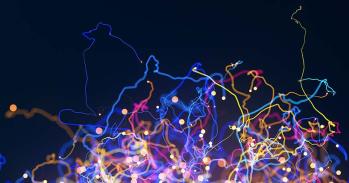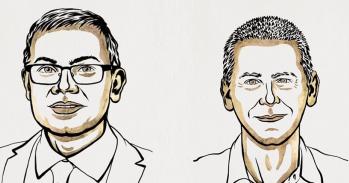
Today’s announcement celebrates the men who triggered the hunt for the Higgs particle, finally discovered last year with help from the ATLAS project and scientists at Cambridge’s Cavendish Laboratory.
Today’s announcement celebrates the men who triggered the hunt for the Higgs particle, finally discovered last year with help from the ATLAS project and scientists at Cambridge’s Cavendish Laboratory.
It is amazing that people like Peter can see so much using mathematics
Andy Parker
This morning, the Royal Swedish Academy of Sciences have awarded Professors Peter Higgs and François Englert the 2013 Nobel Prize in Physics for their 1964 prediction of a new sub-atomic ‘elementary’ particle - known as the Higgs boson - confirmed to exist in the summer of last year by researchers at the Large Hadron Collider (LHC), described as the world’s largest science experiment, following a search of almost forty years.
Peter Higgs is an Emeritus Professor of Theoretical Physics at the University of Edinburgh. He received an Honorary Degree from the University of Cambridge in 2012, the Oratory from which can be read below.
Scientists at the University of Cambridge have been working at the LHC since 1989 and were among the research teams that founded the ATLAS experiment: one of two major experiments - along with the CMS - that led to the discovery of the Higgs particle.
For many in the field, last year’s sighting of the Higgs and the forty year old theory that led to its pursuit amount to the most important scientific discovery of the 21st century - and that the 2013 Nobel Prize in Physics simply couldn’t have gone to anybody other than those that instigated the quest for the elusive particle.
“I’m delighted to hear that Peter Higgs and François Englert have been awarded the Nobel Prize. This discovery changes our view of the way the world works in a very profound way, showing that the apparent solidity of matter is something of an illusion, and that the vacuum itself plays a key role," said Andy Parker, Professor of High Energy Physics at the Cavendish Laboratory and a founder of the ATLAS experiment for the LHC.
"It is amazing that people like Peter can see so much using mathematics. The experimental teams also deserve enormous credit for their skill and determination in revealing one of the best-kept secrets of Nature.”
Parker spent six 6 years as the project leader for the ATLAS Inner Detector. He was part of the team that designed and built some of the “major detector systems” now operating at the LHC, which Cambridge scientists continue to help operate “day and night” to acquire the data which continues to be analysed in the wake of last year’s announcement.
Today’s Nobel Prize in Physics follows on from LHC reports earlier this year that continue to reinforce the evidence showing the Higgs boson exists, and is the means by which particles get their mass.
The ATLAS group is one of the largest collaborative efforts ever attempted in the physical sciences, with some 3,000 physicists (including 1,000 students) participating from more than 174 universities and laboratories in 38 countries.
Cambridge scientists remain integral to the continued efforts at the LHC, involving long-standing collaboration between experimental and theoretical teams at the Cavendish, and theorists at the University’s Department of Applied Mathematics and Theoretical Physics (DAMTP) such as Ben Allanach, who discusses his time at the LHC here.
Parker points out that the Higgs Boson could be part of a larger picture which includes gravity, dark matter and “grand-unification of particles and forces” as, at present, our picture of the sub-atomic world - ruled by quantum mechanics - is incompatible with our picture of the astronomical world - ruled by gravity, he says, and the Cambridge group are active in all of these areas.
“At present our team is studying two versions of this larger picture, using supersymmetry on one hand, and extra space dimensions on the other,” explains Parker.
“Both of these ideas can answer long-standing problems in fundamental physics, and both predict the existence of more unusual particles which could be found at the LHC, including extra Higgs Bosons.
“We are actively searching through the data for such effects.”
A Q and A session with Andy Parker published last year when the initial discovery of the Higgs boson was announced can be read in full here.
Professor Peter Higgs - Honorary Degree Oratory
MOST fecund Muse, whom all adore,
Come help me now, I thee implore,
To sing and praise a trinity
Of men whose bright posterity
Illuminates the path we tread:
The first was he upon whose head
That local apple fell and gave
To Newton fame beyond the grave.
The second drew on gravity
To show through relativity
Whole warping universes bent
And folded back to pay time’s rent.
Now third in line (though not renown)
We have this man, whose scarlet gown
Will light the lands beyond the Wall
Because he saw the root of all.
The briny thickness of the sea
Restrains and binds the arms of he
That seeks to swim against the tides—
His progress slows, slows more, then dies.
Yet heaving swells, both fore and aft,
Do not slow down a well-formed craft
Maintained well by crew and boatswain.
And so it is with what goes on
In the great vacancies of space:
Where wave-like light still wins the race
Against more massy forms of stuff
Which give off energy enough—
By crashing through, out, down, across—
To give birth to the seeds of force
Named for this man—him, over there.
And this is why, quite everywhere,
To prove aright this good Professor
Men in labs smash things together.
Written by Dr Rupert Thompson, translated from Latin by Mark Ynys-Mon
This work is licensed under a Creative Commons Licence. If you use this content on your site please link back to this page.





